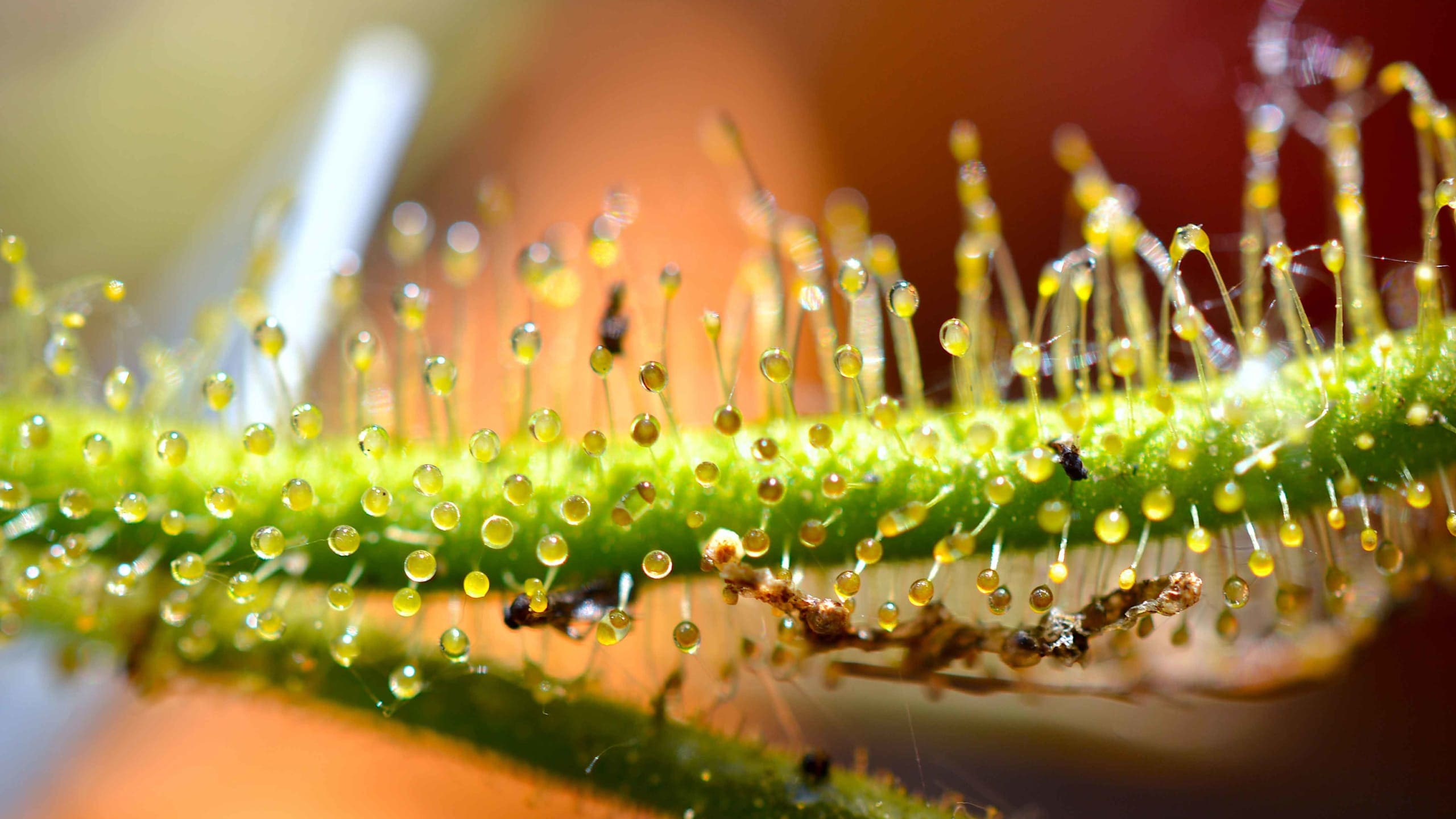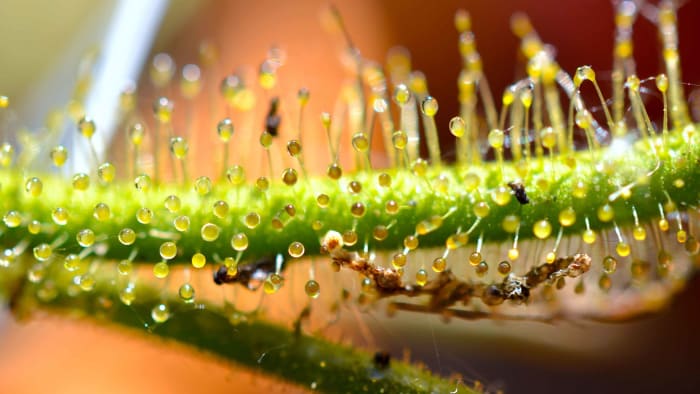 Listen to this article
•
15:34 min
Listen to this article
•
15:34 min
In the monsoon of 2021, I was on a study tour to survey soil arthropods (like spiders, beetles, millipedes, and centipedes) on the rocky plateaus in Maharashtra. Monsoon brings life to these otherwise dry, soil-deficient, and infertile rocky plateaus. They appear as a vast grassy carpet dotted with vibrant wildflowers in the monsoon. I was combing through patches of grass on one such plateau in search of these arthropods, making mental notes of the ground orchids that were standing tall on the grassy carpet and the distinctive colours, shapes, and structures of wildflowers. I chanced upon a tiny plant with tender tentacles, each laden with a string of water droplets. On closer look, I noticed a tiny black ant struggling to escape. The more it wriggled, the more it sank inside the droplet. What drama between life and death! The plant was sundew and my first sighting of a carnivorous plant in the wild. They intrigued me, and I decided to dig deeper into the gripping world of sundews.

It is mind-boggling to see these tiny, adorable plants hoodwinking insects to death. Sundews have mastered the art of fooling insects and other arthropods to consume them. They prey on animals to meet the nutritional demands of their growth. Unlike most animal predators that move in search of prey, sundews are sit-and-wait predators. They trick insects into landing on them and then trap them.
Sundews are interesting and alluring in appearance compared to other herbs. They are as small as a coin and can grow up to 15 cm tall. The presence of specialised trap leaves is their adaptation to acquire nutrients. Sundews belong to the family Droseraceae and have more than 250 known species. India is home to three species of sundews: flycatcher sundew (Drosera indica), Burman’s sundew (Drosera burmanii), and shield sundew (Drosera peltate). All are structurally distinct from each other.

My first sundew sighting was of the commonly seen Drosera indica, also known as flycatcher sundew. Flycatcher sundews can grow half a metre tall. They are found scattered amidst large swathes of grasses on plateaus and near waterbodies. One can see them flowering with delicate, pretty pink flowers towards the end of the monsoon. In India, the flycatcher sundew is primarily seen in the Western Ghats.
On one of the plateaus, we were looking for soil arthropods near a pool of water when we saw another species of sundew, Drosera burmanii. This is my favourite sundew so far. Burman’s sundew resembles a red floral disc with myriad sparkles. It is 2-3 cm in diameter and grows flat on the ground with a rosette of leaves and flowers as the monsoon recedes from September onwards. The flower is elongated, erect, and delicate, arising about ankle height from the red leafy disc. The surface of every leaf is covered with sticky, sugary glands that trap insects. The glands act as an adhesive. When an insect lands on the sticky dews, the leaves curl around it in a matter of seconds. Burman’s is one of the fastest insect-trapping sundews.
On reading up more on sundews, I learned about a third species, shield sundews, that I am yet to see. They are the only perennial sundew in India. Shield sundews have tuberous roots that allow them to survive in poor quality soil. The leaves are green to greenish-yellow and resemble a badge with pearl beaded pins. Shield sundews can grow up to 50 cm, their white or pink flowers standing out from the clump of dewy stems. The basal leaves are spirally arranged and become alternate on the stem. The shield-shaped leaves bear hundreds of glands. Once an insect is trapped, all the glands come together to form a large drop of dew dangling from the shield. The insect is dissolved by the acidic secretion and enzymes present in the dew. This sundew species gives me a reason to revisit these plateaus in the next monsoon.
Sundews are found in places that experience harsh and seasonal climatic conditions, such as the lateritic plateaus of Maharashtra. These plateaus experience the scorching sun in summer and water-logged and nutrient deficient surfaces during the monsoon. The absence or scarcity of soil makes plateaus infertile for most of the year. Hence, the annual habit of sundews is best adapted to such nutrient-deficient ecosystems. They are seen on the banks of seasonal pools too. Open flats with scrubs, on grassy verges, and roadside cliffs are potential microhabitats for sundews. During my expedition, I found flycatcher sundews to be common in grassy patches, whereas Burman’s sundews were found closer to waterbodies.
I find sundews exceptional among plants, and the course of their lifespan is truly dramatic. These sugary illusions have evolved to be strange but have flourished along with their arthropod prey. There are about 250 species of sundews globally. Due to their aesthetics, sundews are in high demand by botanists and floriculturists in the market. They are thought to be medicinally important too. However, overexploitation could lead them to vanish from their natural ranges. Sundews are legally protected to prevent overexploitation from their natural habitats. Under the Wildlife (Protection) Act, 1972, their international export and trade are banned from India. Unfortunately, their critical habitats, such as plateaus, hardly receive the conservation attention they deserve. Most of these plateaus are also famous tourist destinations. I witnessed flocks of tourists crisscrossing through the grasses without pondering the impact of trampling wildflowers, including sundews. The mud-filled tracks created for tourism purposes such as horse-riding has led to the burying of ephemerals (plants with short life cycles). In addition to tourism, plateaus are threatened by grazing, wind farms and mining. These anthropogenic threats disrupt the natural flow of nutrients in these habitats and make the entire ecosystem vulnerable to biodiversity loss. It is reassuring to know that some plateaus are slowly being recognised and receiving legal protections in recent years. For example, the Kaas Plateau was declared a UNESCO World Natural Heritage Site in 2012. In March 2021, the Maharashtra government included a few plateaus in the Sahyadris under the Protected Area Network as conservation reserves. This strengthens my hope that these unique ecosystems will thrive in the future, and interesting species like sundews will continue to amaze future generations.










